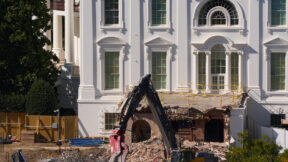The Wayback Machine: Exploring New York City, Circa 1795
 A web developer and former Columbia student undertook a unique project: sketching the evolution of a New York City block, from 1795 to today. The resulting animation, dubbed “The Block” (specifically, Eldridge Street between Rivington and Stanton), is rough in its details but gives a good sense of the highs and lows of the street’s history. The initial appearance of apartments, fires, neglect, urban improvement projects – all captured.
A web developer and former Columbia student undertook a unique project: sketching the evolution of a New York City block, from 1795 to today. The resulting animation, dubbed “The Block” (specifically, Eldridge Street between Rivington and Stanton), is rough in its details but gives a good sense of the highs and lows of the street’s history. The initial appearance of apartments, fires, neglect, urban improvement projects – all captured.

It likely goes without saying, but the creator of the animation, Zach van Schouwen, wasn’t born in 1795. In fact, he probably wasn’t alive in 1975. So how’d he create the images?
A few days ago, I wrote about efforts to expand access to public documents, particularly video. The scale of information created by and about the Federal government is one thing. In New York City, the accreted knowledge of a 400-year history is a whole different issue, a much smaller – and therefore more expansive – scale.
Mr. van Schouwen was, according to a statement on the site, enterprising in taking advantage of what resources exist. The New York Times is the tip of the iceberg, with its decades of information. Buried under the surface of the bureaucratic ocean, though, is much more.
First and foremost is the exceptional job that the New York Public Library has done in digitizing its collection of ephemera. It’s Digital Collection webpage has a surfeit of imagery, much that extends well beyond city limits. Those New York City-centric things, though, include images of city infrastructure in various stages of completion and a robust collection of old menus. More helpful to Mr. van Schouwen, though, were likely the collected floor plans for apartment buildings and early real estate atlases of the city, compiled for insurance purposes.
 The Library is also remarkable for exploring ways in which that content can be displayed in more natural (and helpful) ways. Matt Knutzen, of the Library’s Map Division, explores their huge collection of charts and maps on his blog at NYPL.org. In addition to continually adding new maps, he’s also written about the Library’s use of Google Earth to orient what they find geo-spatially. You can download a Google Earth-friendly .kmz file from the site and explore as you wish. Clicking randomly in lower Manhattan, for example, yielded this map of the area now just north of City Hall in 1853.
The Library is also remarkable for exploring ways in which that content can be displayed in more natural (and helpful) ways. Matt Knutzen, of the Library’s Map Division, explores their huge collection of charts and maps on his blog at NYPL.org. In addition to continually adding new maps, he’s also written about the Library’s use of Google Earth to orient what they find geo-spatially. You can download a Google Earth-friendly .kmz file from the site and explore as you wish. Clicking randomly in lower Manhattan, for example, yielded this map of the area now just north of City Hall in 1853.
Many of these charts and records stem from the City’s centuries of public record-keeping – much of which is still available from the City’s Municipal Archives. For example, for its tax records the City has twice undertaken a massive project: photographing every building in the city. The images, taken around 1940 and again in the mid-1980s, provides a high-resolution Google Street View-style look at the city in those moments.
Or so one would assume. Unfortunately, the collection has, for years, been available only by traveling down to the Archives building and viewing lo-res versions – making the high resolution shots available only upon purchase. (When I earlier referred to Mr. van Schouwen as enterprising – he was. He used this method to draw some of his buildings.) The intent was to raise money; the effect was to close off a treasure trove of information.

From New York City Municipal Archives, via the New York Times
Good news, however – the Times reported just yesterday that the City is exploring a deal to put the photos online. (With whom? Google, of course.) While still providing an outlet to sell high-resolution prints, the images themselves would be put online for view.
New Yorkers are helped in their efforts to explore the city’s history by a number of good local blogs, including Gothamist which, while not focused on history, does popularize some gems. This week alone they celebrated the history of LaGuardia Airport and posted historic photos of department store Santas.
I’m hugely excited, obviously, by ways in which historic items come to light and, as in the case with “The Block”, are explored and re-contextualized. Providing broader access to public information – through the work of municipalities and other government bodies, large institutions, and individuals – is inevitable, and promises an incomprehensibly rich future of understanding our collective history.
This is an opinion piece. The views expressed in this article are those of just the author.




